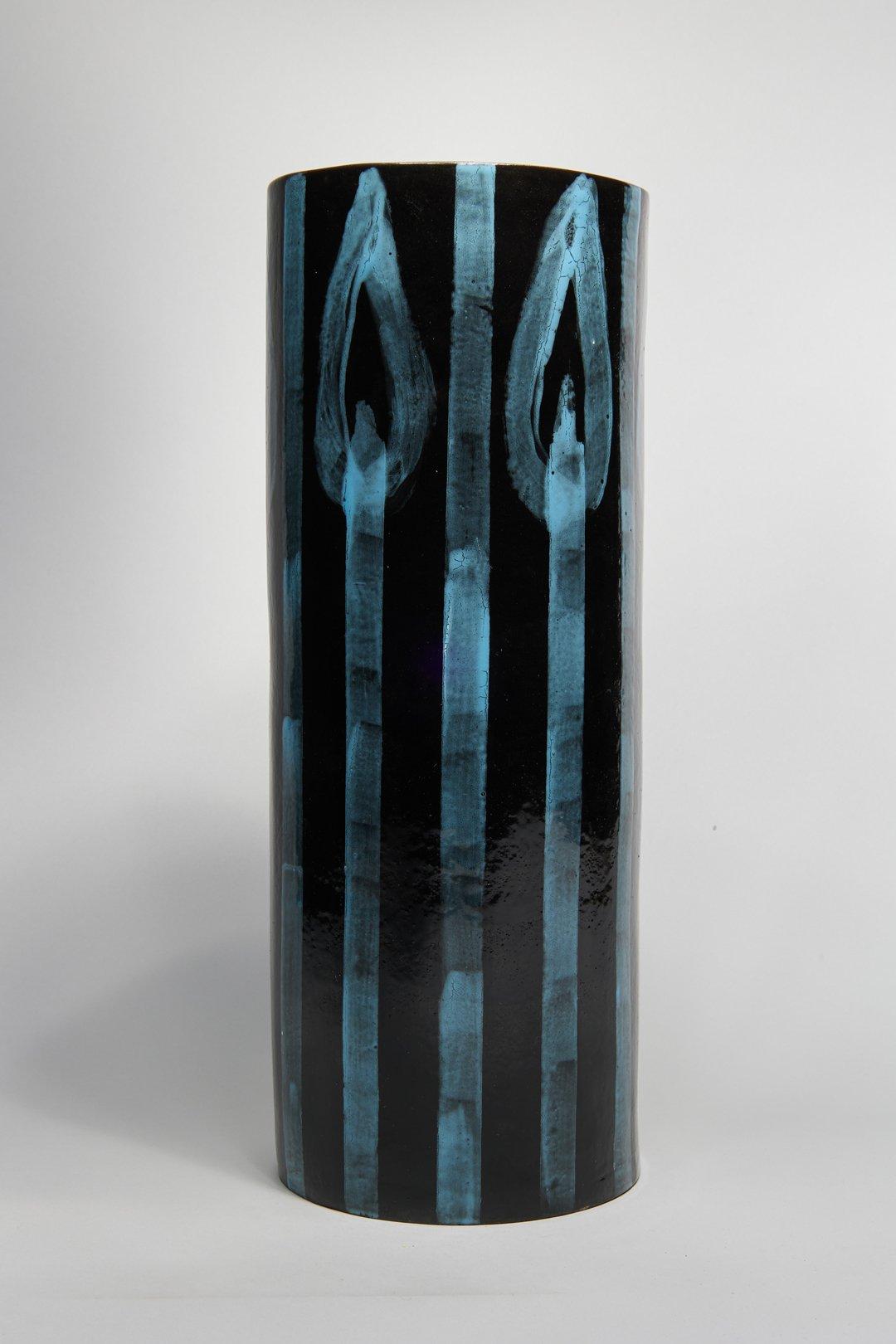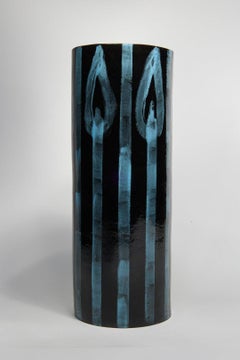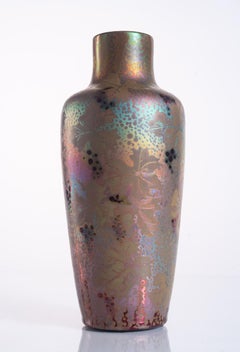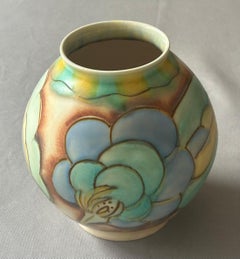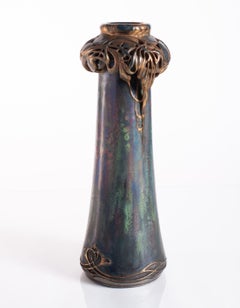Items Similar to Vase with Flowery medallions
Want more images or videos?
Request additional images or videos from the seller
1 of 5
Gabriel Argy-RousseauVase with Flowery medallionscirca 1925
circa 1925
$28,835.54
£22,027.93
€24,500
CA$40,630.54
A$44,738.13
CHF 23,198.68
MX$529,822.49
NOK 294,492.37
SEK 275,236.49
DKK 186,645.71
About the Item
Vase known as "Flowery medallions"
Gabriel ARGY-ROUSSEAU (1885-1953)
Made in cameo glass (pâte de verre),
ornated with a wide violet-blue wave motif frieze,
adorned with three red-coral colour flowery medallions.
Signed " G. Argy-Rousseau "
Perfect condition
France
circa 1925
height 25,5 cm
diameter 13 cm
Model presented in 1925, reproduced in "Les pâtes de verre, catalogue raisonné G. Argy-Rousseau", Les éditions de l'amateur, p. 68 and 206.
Biography :
Joseph Gabriel Rousseau called Gabriel Argy-Rousseau (1885-1953) was a French sculptor, ceramist and glassmaker who contributed to the rediscovery of cameo glass as a major glass art of the early twentieth century. If the technique of cameo glass dates back to ancient times, it fell into oblivion for a long time. In the last quarter of the nineteenth century, Henri Cros and a handful of artists, often ceramists of the Art Nouveau movement, such as François Décorchemont or Georges Despret, put it in the spotlight. The last of these precursors was Gabriel Argy-Rousseau. He was considered as the only glassmaker to have developed and used the complex process of cameo glass, the other glassmakers working with crystal paste.
Entering the Ceramics School of Sèvres, he discovered the cameo glass in the workshop of Henri Cros. Gabriel Argy-Rousseau began to produce between 1910 and 1920. His early works were influenced by Art Nouveau style plant motifs and animal themes. He began at the 1914 Salon of the French Artists in Paris. Between 1921 and 1931, established rue Simplon in Paris, he was a shareholder in the Argy-Rousseau cameo Glass Society. With many collaborators, he produced small very colorful Art Nouveau and Art Deco subjects, distributed in small series: pendants, vases, lamps and night lights and, from 1928, sculptures (statuettes or bas-reliefs) in collaboration with Marcel Bouraine. Unlike his fellow ceramicists, he remained belatedly faithful to the polychrome effects and floral motifs of Art Nouveau style. He developed shimmering colors (ruby red, amethyst, gray, deep blue ...) and textures with marbled effects. He invented new processes for the superficial coloring of the paste, by painting oxide powder before second firing at a low temperature. His works were in glass paste, the statuettes usually in crystal paste.
The glass creations of Gabriel Argy-Rousseau remain among the most typical and representative examples of Art Deco production. The production of the workshop ceased in 1931, but Argy-Rousseau continued to create pieces of crystal paste, because of the economic crisis, the opportunity to work the expensive process of the glass paste was no longer possible. He exhibited punctually, especially in 1934, glassware adorned with precious metals. His last exhibition took place a year before his death in 1952. He died forgotten, but left many works in the glass branch, now rediscovered.
Joseph Gabriel Rousseau called Gabriel Argy-Rousseau (1885-1953) was a French sculptor, ceramist and glassmaker who contributed to the rediscovery of cameo glass as a major glass art of the early twentieth century. If the technique of cameo glass dates back to ancient times, it fell into oblivion for a long time. In the last quarter of the nineteenth century, Henri Cros and a handful of artists, often ceramists of the Art Nouveau movement, such as François Décorchemont or Georges Despret, put it in the spotlight. The last of these precursors was Gabriel Argy-Rousseau. He was considered as the only glassmaker to have developed and used the complex process of cameo glass, the other glassmakers working with crystal paste. Entering the Ceramics School of Sèvres, he discovered the cameo glass in the workshop of Henri Cros. Gabriel Argy-Rousseau began to produce between 1910 and 1920. His early works were influenced by Art Nouveau style plant motifs and animal themes. He began at the 1914 Salon of the French Artists in Paris. Between 1921 and 1931, established rue Simplon in Paris, he was a shareholder in the Argy-Rousseau cameo Glass Society. With many collaborators, he produced small very colorful Art Nouveau and Art Deco subjects, distributed in small series: pendants, vases, lamps and night lights and, from 1928, sculptures (statuettes or bas-reliefs) in collaboration with Marcel Bouraine. Unlike his fellow ceramicists, he remained belatedly faithful to the polychrome effects and floral motifs of Art Nouveau style. He developed shimmering colors (ruby red, amethyst, gray, deep blue ...) and textures with marbled effects. He invented new processes for the superficial coloring of the paste, by painting oxide powder before second firing at a low temperature. His works were in glass paste, the statuettes usually in crystal paste. The glass creations of Gabriel Argy-Rousseau remain among the most typical and representative examples of Art Deco production. The production of the workshop ceased in 1931, but Argy-Rousseau continued to create pieces of crystal paste, because of the economic crisis, the opportunity to work the expensive process of the glass paste was no longer possible. He exhibited punctually, especially in 1934, glassware adorned with precious metals. His last exhibition took place a year before his death in 1952. He died forgotten, but left many works in the glass branch, now rediscovered.

About the Seller
5.0
Recognized Seller
These prestigious sellers are industry leaders and represent the highest echelon for item quality and design.
Established in 1992
1stDibs seller since 2023
11 sales on 1stDibs
Typical response time: 12 hours
- ShippingRetrieving quote...Shipping from: PARIS, France
- Return Policy
More From This Seller
View AllImportant vase with Clematis
By Émile Gallé
Located in PARIS, FR
Important vase with Clematis
by Etablissements GALLE
A very important baluster shaped vase with a flared neck
Multilayer glass
decorated with acid-etched blue and brown Clematis
on...
Category
Early 20th Century Art Nouveau More Art
Materials
Glass
Vase with Clematis
By Émile Gallé
Located in PARIS, FR
Vase with Clematis
by Émile GALLE (1846-1904)
A baluster-shaped vase ornated with clematis.
Green, purple and opalescent multi-layered glass.
The fine floral decoration was made bo...
Category
Early 20th Century Art Nouveau More Art
Materials
Blown Glass
"Bellflowers" Vase
By Émile Gallé
Located in PARIS, FR
"Bellflowers" Vase
by Émile GALLE (1846-1904)
A very rare shell-shaped vase,
double-layered blown glass with powder and silver foil inclusions.
Wheel-carved cameo decoration ornate...
Category
Early 20th Century Art Nouveau More Art
Materials
Blown Glass
Flowery Cristallerie Vase
By Émile Gallé
Located in PARIS, FR
Flowery Cristallerie Vase
by Emile GALLE (1846-1904)
Vase called "Cristallerie de Gallé"
Vase with rounded body and flaring neck,
ornated with stylized flowers and foliage.
Smoked ...
Category
Late 19th Century Art Nouveau More Art
Materials
Glass
Cristallerie – Vase with Lady's Slipper
By Émile Gallé
Located in PARIS, FR
Cristallerie – Vase with Lady's Slipper
by Emile GALLE (1846-1904)
Vase known as "Cristallerie by Gallé",
decorated with Lady's Slippers, a plant from the orchid family,
flanked by ...
Category
Late 19th Century Art Nouveau More Art
Materials
Blown Glass
Vase with Roses
By Daum
Located in PARIS, FR
Vase with Roses
by DAUM
A baluster-shaped vase, with flared neck,
Multi-layer blown-molded glass,
with roses decoration.
With acid-etched decor in reserve, and wheel-carved rose pet...
Category
1920s Art Nouveau More Art
Materials
Blown Glass
You May Also Like
Large 20th Century Ceramic Vase w/ Flowers, French Artist
By Roger Capron
Located in Beachwood, OH
Roger Capron (French, 1922-2006)
Vase
Ceramic
Signed on bottom
15.75 x 6 inches
French ceramist Roger Capron was born in Vincennes in 1922. He studied at Paris’s School of Applied A...
Category
Late 20th Century More Art
Materials
Ceramic
$2,400 Sale Price
20% Off
Grapevine Vase by Clement Massier, Art Nouveau c. 1900
By Clement Massier
Located in Chicago, IL
Ceramic vase in a blue and green metallic lustre glaze by master of iridescence Clement Massier, with clusters of grapes and leaves in deep purple. Signed MCM in the base, and number...
Category
Early 1900s Art Nouveau More Art
Materials
Ceramic
Carltonware Art Deco 1930s Vase
Located in Bournemouth, Dorset
A beautiful 1930s Carlton Ware Art Deco Garden pattern vase of shouldered ovoid form, decorated with iconic art deco shapes on a green, blue, yellow and beige background , pattern no...
Category
1930s Contemporary More Art
Materials
Ceramic
$192 Sale Price
20% Off
Floral Wreath Vase by Paul Dachsel for Amphora c. 1900
Located in Chicago, IL
Tall Amphora vase with a floral wreath encircling the mouth, trailing down on two sides into light green and rose crackling, and finished with a linear "Dachsel style" relief in the ...
Category
1890s Art Nouveau More Art
Materials
Ceramic
Enamel Floral Vase by Camille Fauré
By Camille Fauré
Located in Miami, FL
Art Deco Enamel Floral vase in Pastel colors by Camille Fauré.
Signature: C. Fauré. Limoges, France.
Category
20th Century French Art Deco Vases
Materials
Enamel, Bronze
Amphora Vase with Water Lilies by Ernst Wahliss, att. Paul Dachsel, c. 1900
Located in Chicago, IL
Earthy, textured water lily leaf vase with gilted, figural stem arms which encircle the golden mouth of the piece with their flowers. Stamped Ernst Wahliss and numbered in the base. ...
Category
Late 19th Century Art Nouveau More Art
Materials
Ceramic
